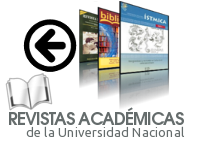Representaciones a través del cine: La interpretación de los procesos históricos para la enseñanza de los Estudios Sociales
DOI:
https://doi.org/10.15359/rp.27.3Palabras clave:
cine, procesos históricos, historia, Estudios Sociales, enseñanza, interpretaciónResumen
Se presenta un estudio sobre el uso del cine en la asignatura de Estudios Sociales, que tuvo como propósito describir la utilización de filmes para la explicación e interpretación de los procesos históricos, por parte del profesorado de Estudios Sociales. La investigación partió de diversas consideraciones teórico-metodológicas donde se muestra el cine en los procesos de enseñanza y aprendizaje de la historia, en la que se manifiesta la construcción de un pensamiento crítico y conciencia histórica del personal docente. Por medio de un estudio cualitativo de paradigma fenomenológico, con la técnica de grupo focal se mostró la necesidad de transformaciones educativas como lo es la aplicación del cine para la explicación de los procesos históricos, ya que por medio de dicha herramienta se superan prácticas tradicionales de la docencia. El principal hallazgo de la investigación fue el aprovechamiento de diversas estrategias que posibiliten una educación histórica en el estudiantado como lo es el cine.
Referencias
Acosta, W. (2018). El cine como objeto de estudio de la historia: Apuestas conceptuales y metodológicas. Universidad Pedagógica Nacional, (47), 51-68. https://www.redalyc.org/journal/3459/345958295004/html/
Badilla, L. (2006). Fundamentos del paradigma cualitativo en la investigación educativa. Revista de Ciencias del Ejercicio y la Salud, 4(1), 42-51. https://10.15517/pensarmov.v4i1.411
Cortés, A. (2018). El cine: Una herramienta didáctica para enseñar historia. Revista RedCA, 1(2), 66-85.
Fraga, E. (2018). El cine y su aplicación en un aula: Una propuesta didáctica sobre la Alemania nazi [tesis de Maestría, Universitat de les Illes Balears].
García, M. (2010). Cine y educación: La integridad del docente en Emperor 's club. Edetania, (38), 27-40. https://revistas.ucv.es/index.php/Edetania/article/view/296/256
Hamui, A y Varela, M. (2012). La técnica de grupos focales. Revista Elsevier, (2), 55-60. https://www.elsevier.es/es-revista-investigacion-educacion-medica-343-pdf-S2007505713726838
Katayama, J. (2014). Introducción a la investigación cualitativa: Fundamentos, métodos, estrategias y técnicas. Fondo Editorial.
Monge, C. (2011). Metodología de la investigación cuantitativa y cualitativa, guía didáctica. Universidad Surcolombia. https://www.uv.mx/rmipe/files/2017/02/Guia-didactica-metodologia-de-la-investigacion.pdf
Morantes, S. y Gordillo, Y. (2016). El cine, una estrategia para desarrollar habilidades del pensamiento crítico en sociales. Revista Educación y Ciencia, (20), 113-126. https://dialnet.unirioja.es/servlet/articulo?codigo=7982048
Peñalver, T. (2015). El cine como recurso didáctico: Una propuesta de programación didáctica. Edetania, (45), 221-232. https://dialnet.unirioja.es/servlet/articulo?codigo=5349046
Pulido, M. (2016). El cine en el aula: Una herramienta pedagógica eficaz. Opción, 32(8), 519-538. https://www.redalyc.org/articulo.oa?id=31048481031
Quecedo, R y Castaño, C. (2002). Introducción a la metodología de investigación cualitativa. Revista psicodidáctica, (14), 5-39. https://www.redalyc.org/articulo.oa?id=17501402
Rodríguez, J. (2014). El cine en la realidad de las aulas. Historia y Comunicación Social, (19), 565-574. https://doi.org/10.5209/rev_HICS.2014.v19.45161
Skate, R. (1999). Investigación con estudio de casos. Ediciones Morata.
Solis, L. (2018). El cine: Una fuente apta para reconstruir el pasado. Revista Horizonte Histórico, (15), 43-53. https://revistas.uaa.mx/index.php/horizontehistorico/article/view/1497
Vidovic, J y Chourio, D. (2012). El cine como estrategia didáctica para la enseñanza de la historia. Revista de la Universidad del Zulia 3ª época, 3(7), 97-114. https://produccioncientificaluz.org/index.php/rluz/article/view/31205
Publicado
Cómo citar
Número
Sección
Licencia
Los autores que publican en esta revista están de acuerdo con los siguientes términos:
a) Los autores conservan los derechos de autor y garantizan a la revista el derecho de ser la primera publicación del trabajo bajo una Licencia Creative Commons Atribución-NoComercial-CompartirIgual 4.0 Internacional (https://creativecommons.org/licenses/by-nc-sa/4.0/) que permite a otros compartir el trabajo con un reconocimiento de la autoría del trabajo y la publicación inicial en esta revista (componente BY o atribución). Coincidente con la política de Acceso Abierto, no se podrán hacer usos comerciales de los contenidos publicados por esta revista (componente NC). Se permitirán las obras derivadas (remezcla, transformación o creación a partir de la obra original) siempre y cuando sean distribuidas bajo la misma licencia de la obra original (componente SA).
b) Los autores pueden establecer por separado acuerdos adicionales para la distribución no exclusiva de la versión original de la obra publicada en la revista (por ejemplo, situarlo en un repositorio institucional o publicarlo en un libro), siempre y cuando: a) sea reconocida la publicación original en esta revista (componente BY); b) no se haga uso del material de reuso con propósitos comerciales (componente NC); c) el material de reuso sea distribuido bajo la misma licencia de la obra original (componente SA).
c) Se permite y se anima a los autores a difundir sus trabajos electrónicamente (por ejemplo, en repositorios institucionales o en su propio sitio web) antes y durante el proceso de envío, ya que puede dar lugar a intercambios productivos, así como a una citación más temprana y mayor de los trabajos publicados (Véase The Effect of Open Access) (en inglés).


_11.55_.09_a_._m_._.png)
_1.34_.01_p_._m_._2.png)
_9.45_.02_p_._m_._.png)




_2.23_.09_p_._m_._.png)
_2.35_.17_p_._m_._.png)

